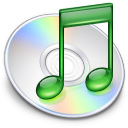The cool thing about Apple's iTunes is that it is singlehandedly bringing back the 45 rpm single market, which has been missing in action for about 20 years.

Remember 45's? They used to be very popular. They were how the Beatles and Elvis Presley made their mark. In the sixties, the 7-inch 45 rpm vinyl single was the primary way popular music was marketed. Music stores carried racks and racks of them, they were inexpensive (I think I'm remembering under a dollar each) and they were fun to collect and play. And before 45's there were 78 rpm shellac singles.
There was only room for one song per side, so even though it was called a "single" it was really a "double". The "B side" offered an additional freebie song from the artist. And while there are examples of B sides that were as good as or better than the A sides, the phrase "B side" came to mean a song that didn't have a chance of charting, or something cool and obscure from the source of a well-known hit.
The Billboard Charts were important too, as they tallied the sales of 45 rpm singles. You could watch a song be introduced (with a bullet!), climb up the charts, enjoy popularity, and phase out as it was replaced with other songs. "Top 40" radio stations would not only have playlists that were similar to the Billboard Charts, but they would often celebrate and have contests to predict the top songs each week. In the 1940's it was "Your Hit Parade", in 1970 it was Casey Kasem's "American Top 40". Record stores often followed suit and had a special promotional display for the top 40 singles.
But the popularity of the Compact Disc in the 1980's effectively killed the single. Not only the 45 rpm vinyl single, but the sales of single songs in any format. Sure, there did exist a small market of "CD singles" (compact discs with one song on them) for a short time, and there did exist small format 3-inch compact discs, but I challange you to find somebody who actually has any of these in their music collection. The compact disc turns out to be the wrong format for delivering single songs, both economically and from a point of presentation.
And during this period the Billboard Charts stopped existing as such. Why bother charting the sales of something that has no market? Instead the Billboard charts evolved to tally CD sales, and radio play, and other variants, but not actual single sales. (Jeeze, why don't they just tally the payola directly and be done with it.)

But, look at this: Apple's iTunes sells (hold on tight now...) single songs. This is exactly the domain of the missing 45 rpm vinyl single. iTunes is the 21st century version of the music store that sells 45 rpm singles.
Apple's iTunes will be wildly successful for a long time to come because they are tapping into a market that is natural, trendy and timeless. And since the market has been missing for so long, the pent-up demand has been substantial enough to overcome any startup issues.
And note that iTunes provides high tech delivery of an ancient product (recorded music has been around for about a century) where brick-and-mortar retail sales has difficulty stocking lots of titles. 'Just like Amazon.
It's a remarkable business model. Steve Jobs has done something the music industry (specifically the four major record labels) couldn't handle themselves. iTunes has already had, and will continue to have, a major impact on the music industry.
And note that starting this year Billboard is charting paid song downloads.
Refs:
Billboard Music Charts
Wikipedia's Billboard Magazine entry
Wikipedia's 45rpm Single entry
Wikipedia's Gramphone Record entry

Post a comment
Thanks for signing in, . Now you can comment. (sign out)
(If you haven't left a comment here before, you may need to be approved by the site owner before your comment will appear. Until then, it won't appear on the entry. Thanks for waiting.)